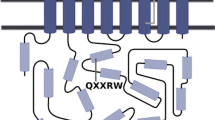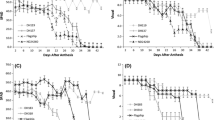Abstract
The use of dwarfing genes has resulted in the most significant improvements in yield and adaptation in cereal crops. The allelic dwarfing gene sdw1/denso has been used throughout the world to develop commercial barley varieties. The sdw1 gene has never been used successfully for malting barley, but only for a large number of feed varieties. One of the gibberellin 20-oxidase genes (Hv20ox 2 ) was identified as the candidate gene for sdw1/denso. Semi-quantitative real-time RT-PCR revealed that Hv20ox 2 was expressed at different levels in various organs of barley. Transcriptional levels were reduced in leaf blade, sheath, stem and rachis tissue in the barley variety Baudin with the denso gene. Subsequently, the relative expression levels of Hv20ox 2 were determined by quantitative real-time RT-PCR in a doubled haploid population and mapped as a quantitative trait. A single expression quantitative trait locus (eQTL) was identified and mapped to its structural gene region on chromosome 3H. The eQTL was co-located with QTLs for yield, height, development score, hectolitre weight and grain plumpness. The expression level of Hv20ox 2 was reduced fourfold in the denso mutant, but around 60-fold in the sdw1 mutant, compared to the control variety. The reduced expression level of Hv20ox 2 enhanced grain yield by increasing the number of effective tillers, but had negative effects on grain and malting quality. The sdw1 gene can be used only in feed barley due to its severe reduction of Hv20ox 2 expression. The gene expression marker for Hv20ox 2 can be used to distinguish different alleles of sdw1/denso.






Similar content being viewed by others
References
Ashikari M, Sasaki A, Ueguchi-Tanaka M, Itoh H, Nishimura A et al (2002) Loss-of-function of a rice gibberellin biosynthetic gene, GA20 oxidase (GA20ox-2), led to the rice ‘green revolution’. Breed Sci 52:143–150
Bernardo AN, Bradbury PJ, Ma H, Hu S, Bowden RL et al (2009) Discovery and mapping of single feature polymorphisms in wheat using Affymetrix arrays. BMC Genomics 10:251
Bezant J, Laurie D, Pratchett N, Chojecki J, Kearsey M (1997) Mapping QTLs controlling yield and yield components in a spring barley (Hordeum vulgare L.) cross using marker regression. Mol Breed 3:29–38
Brem RB, Yvert G, Clinton R, Kruglyak L (2002) Genetic dissection of transcriptional regulation in budding yeast. Science 296:752–755
Cakir M, Gupta S, Li C, Eckermann P, Hayden M et al (2011) Genetic map construction and QTL analysis of the disease traits in the barley population Baudin × AC Metcalfe. Crop Pasture Sci (in press)
Coventry SJ, Barr AR, Eglinton JK, McDonald GK (2003) The determinants and genome locations influencing grain weight and size in barley (Hordeum vulgare L.). Aust J Agric Res 54:1103–1115
Cuesta-Marcos A, Casas AM, Hayesn PM, Gracia MP, Lasa JM et al (2009) Yield QTL affected by heading date in Mediterranean grown barley. Plant Breed 128:46–53
Doerge RW (2002) Mapping and analysis of quantitative trait loci in experimental populations. Nat Rev Genet 3:43–52
Doerge RW, Churchill GA (1996) Permutation tests for multiple loci affecting a quantitative character. Genetics 142:285–294
Dos S, Schadt EE, Drake TA, Lusis AJ (2005) Cis-acting expression quantitative trait loci in mice. Genome Res 15:681–691
Druka A, Potokina E, Luo Z, Bonar N, Druka I et al (2008) Exploiting regulatory variation to identify genes underlying quantitative resistance to the wheat stem rust pathogen Puccinia graminis f. sp. tritici in barley. Theor Appl Genet 117:261–272
Ellis RP, Forster BP, Gordon DC, Handley LL, Keith RP et al (2002) Phenotype/genotype associations for yield and salt tolerance in a barley mapping population segregating for two dwarfing genes. J Exp. Bot 53:1163–1176
Evans DE, Li C, Harasymow S, Roumeliotis S, Eglinton JK (2009) Improved prediction of malt fermentability by the measurement of the diastatic power enzymes, β-amylase, α-amylase and limit dextrinase: II. Impact of barley genetics, growing environment and gibberellin on levels of α-amylase and limit dextrinase in malts. J Am Chem Soc Brew Chem 67:14–22
Fettell NA, Moody DB, Long N, Flood RG (1999) Determinants of grain size in malting barley. In: Proceedings of the 9th Australian barley technical symposium, September 1999, Melbourne, Australia
Franckowiak JD, Pecio A (1992) Coordinator’s report: a listing of genetic stocks. Barley Genet Newsl 21:116–126
Gallagher LW, Jackson LF, Schaller CW, Puri YP, Vogt HE (1996) Registration of ‘UC 828’ barley. Crop Sci 36:466
Gibson G, Weir B (2005) The quantitative genetics of transcription. Trends Genet 21:616–623
Groat I, Briggs DE (1969) Gibberellins and α-amylase formation in germinating barley. Phytochemistry 8:1615–1627
Hellewell KB, Rasmusson DC, Gallo-Meagher M (2000) Enhancing yield of semidwarf barley. Crop Sci 40:352–358
Ivandic V, Malyshev S, Korzum V, Gramer A, Börner A (1999) Comparative mapping of a gibberellic acid-insensitive dwarfing gene (Dwf2) on chromosome 4HS in barley. Theor Appl Genet 98:728–731
Jacobsen JV, Scandalios JG, Varner JE (1970) Multiple forms of amylase induced by gibberellic acid in isolated barley aleurone layers. Plant Physiol 45:367–371
Jansen RC, Nap JP (2001) Genetical genomics: the added value from segregation. Trends Genet 17:338–391
Jia QJ, Zhang JJ, Westcott S, Zhang XQ, Bellgard M et al (2009) GA-20 oxidase as a candidate for the semidwarf gene sdw1/denso in barley. Funct Integr Genomics 9:255–262
Jordan MC, Somers DJ, Banks TW (2007) Identifying regions of the wheat genome controlling seed development by mapping expression quantitative trait loci. Plant Biotech J 5:442–453
Kirst M, Myburg AA, De León JPG, Kirst ME, Scott J et al (2004) Coordinated genetic regulation of growth and lignin revealed by quantitative trait locus analysis of cDNA microarray data in and interspecific backcross of Eucalyptus. Plant Physiol 135:2368–2378
Lapitan NL, Hess A, Cooper B, Botha AM, Badillo D et al (2009) Differentially expressed genes during malting and correlation with malting quality phenotypes in barley (Hordeum vulgare L.). Theor Appl Genet 118:937–952
Li JZ, Huang XQ, Heinrichs F, Ganal MW, Röder MS (2006) Analysis of QTLs for yield components, agronomic traits, and disease resistance in an advanced backcross population of spring barley. Genome 49:454–466
Mickelson HR, Rasmusson DC (1994) Genes for short stature in barley. Crop Sci 34:1180–1183
Monna L, Kitazawa N, Yoshino R, Suzuki J, Masuda H, Maehara Y et al (2002) Positional cloning of rice semidwarfing gene, sd-1: rice “green revolution gene” encodes a mutant enzyme involved in gibberellin synthesis. DNA Res 9:11–17
Potokina E, Caspers M, Wang M, Prasad M, Kota R et al (2004) Functional association between malting quality trait components and cDNA array based expression patterns in barley (Hordeum vulgare L.). Mol Breed 14:153–170
Potokina E, Prasad M, Malysheva L, Röder MS, Graner A (2006) Expression genetics and haplotype analysis reveal cis regulation of serine carboxypeptidase I (Cxp1), a candidate gene for malting quality in barley (Hordeum vulgare L.). Funct Integr Genomics 6:25–35
Potokina E, Druka A, Luo Z, Moscou M, Wise R et al (2008a) Tissue-dependent limited pleiotropy affects gene expression in barley. Plant J 56(2):287–296
Potokina E, Druka A, Luo Z, Wise R, Waugh R et al (2008b) Gene expression quantitative trait locus analysis of 16 000 barley genes reveals a complex pattern of genome-wide transcriptional regulation. Plant J 53:90–101
Powell W, Caligari PDS, Thomas WTB, Jinks TL (1985) The effects of major genes on quantitatively varying characters in barley. 2. The denso and daylength response loci. Heredity 54:349–352
Powell W, Thomas WTB, Baird E, Lawrence P, Booth A et al (1997) Analysis of quantitative traits in barley by the use of amplified fragment length polymorphisms. Heredity 79:48–59
Rasmusson DC (1991) A plant breeder’s experience with ideotype breeding. Field Crops Res 26:191–200
Read BJ, Macdonald AF (1991) Hordeum vulgare (barley) cv. Yerong. Aust J Exp Agric 31:866
Rifkin SA, Kim J, White KP (2003) Evolution of gene expression in the Drosophila melanogaster subgroup. Nat Genet 33:138–144
Sakamoto T, Miura K, Itoh H, Tatsumi T, Ueguchi-Tanaka M et al (2004) An overview of gibberellin metabolism enzyme genes and their related mutants in rice. Plant Physiol 134:1–12
Sasaki A, Ashikari M, Ueguchi-Tanaka M, Itoh H, Nishimura A et al (2002) A mutant gibberellin-synthesis gene in rice. Nature 416:701–702
Schadt EE, Monks SA, Drake TA, Lusis AJ, Che N et al (2003) Genetics of gene expression surveyed in maize, mouse and man. Nature 422:297–302
Shi C, Uzarowska A, Ouzunova M, Landbeck M, Wenzel G et al (2007) Identification of candidate genes associated with cell wall digestibility and eQTL (expression quantitative trait loci) analysis in a Flint × Flint maize recombinant inbred line population. BMC Genomics 8:22
Spielmeyer W, Ellis MH, Chandler PM (2002) Semidwarf (sd-1), green revolution rice, contains a defective gibberellin 20-oxidase gene. Proc Natl Acad Sci USA 99:9043–9048
Spielmeyer W, Ellis M, Robertson M, Ali S, Lenton JR et al (2004) Isolation of gibberellin metabolic pathway genes from barley and comparative mapping in barley, wheat and rice. Theor Appl Genet 109:847–855
Suprunova T, Krugman T, Distelfeld A, Fahima T, Nevo E et al (2007) Identification of a novel gene (Hsdr4) involved in water-stress tolerance in wild barley. Plant Mol Biol 64:17–34
Thomas WTB, Powell W, Swanston JS (1991) The effects of major genes on quantitatively varying characters in barley. 4. The GPert and denso loci and quality characters. Heredity 66:381–389
Thomas WTB, Powell W, Waugh R, Forster BP, Chalmers KJ et al (1995) Quantitative trait loci in a North West European spring barley cross, Blenheim × E224/3. Barley Genet Newsl 24:41–45
Von Korff M, Wang H, Léon J, Pillen K (2006) AB-QTL analysis in spring barley: II. Detection of favourable exotic alleles for agronomic traits introgressed from wild barley (H. vulgare ssp. spontaneum). Theor Appl Genet 112:1221–1231
Yadav SK, Luthra YP, Sood DR, Aggarwal NK (2000) Gibberellic acid (GA3) induced changes in proanthocyanidins and malt quality of two and six-row husked barleys. Plant Foods Hum Nutr 55:87–96
Yang J, Hu CC, Ye XZ, Zhu J (2005) Qtlnetwork 2.0. Institute of Bioinformatics, Zhejiang University, Hangzhou. http://ibi.zju.edu.cn/software/qtlnetwork
Yin X, Stam P, Johan DC, Kropff MJ (1999) AFLP mapping of quantitative trait loci for yield-determining physiological characters in spring barley. Theor Appl Genet 99:244–253
Zadoks JC, Chang TT, Konzak CF (1974) A decimal code for the growth stages of cereals. Weed Res 14:415–421
Zhang J, Zhen L, Zhang CH (2006) Analysis on the dwarfing genes in Zhepi 1 and Aizao 3: two dwarfing gene donors in barley breeding in China. Agric Sci China 5:643–647
Acknowledgments
This project is supported by the Grain Research & Development Corporation of Australia, earmarked fund for Modern Agro-industry Technology Research System of China, Major International Scientific and Technological Joint Research Program of Zhejiang (2008C14072), National Natural Science Foundation of China (30828023 & 30800686) and Zhejiang Natural Science Foundation (Y308495).
Author information
Authors and Affiliations
Corresponding author
Additional information
Communicated by T. Komatsuda.
Rights and permissions
About this article
Cite this article
Jia, Q., Zhang, XQ., Westcott, S. et al. Expression level of a gibberellin 20-oxidase gene is associated with multiple agronomic and quality traits in barley. Theor Appl Genet 122, 1451–1460 (2011). https://doi.org/10.1007/s00122-011-1544-5
Received:
Accepted:
Published:
Issue Date:
DOI: https://doi.org/10.1007/s00122-011-1544-5




